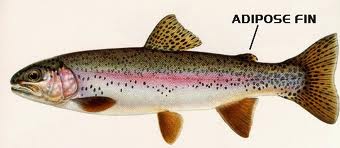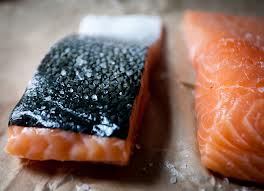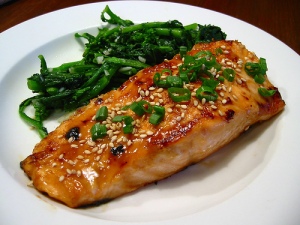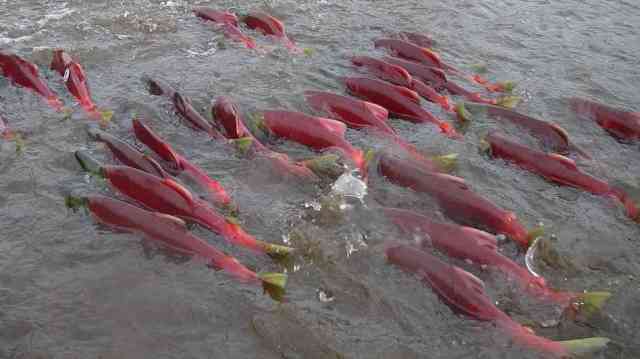I’ve never done a post on salmon and I don’t know why – it’s something we make sure we never buy frozen (or previously frozen and thawed), and we avoid farm raised in lieu of better tasting wild fish. But although most of the world thinks Oregon is home to lots of salmon, I doubt we’re ever getting an Oregon caught salmon at the fish market – most of our wild salmon is coming from Alaska these days – and that’s wonderful stuff, so we don’t complain.
There are many reasons our Oregon salmon is dwindling – the construction of hydroelectric dams on many of the rivers – destruction of habitat through forest clear-cutting and alternative uses of the land – the diversion of river water for agricultural purposes – and the impact of overfishing throughout the last century. All of these and more have resulted in a once vibrant and active fleet of commercial salmon fishing boats in the Pacific Northwest (more than 4000 in 1980 landed more than 11 million pounds of salmon) shrinking significantly (less than 385 boats in 2011 landed less than 500,000 pounds).
 Although the recent catches noted above reflect mandatory restrictions and quotas, and the fishery is actually improving, it’s still surprising when we see ‘Oregon Wild Salmon‘ in our fish markets these days – and that’s sad. And most people would be surprised to learn that when they did buy a true Oregon Chinook salmon, there was only a small chance that it was a real wild salmon rather than a hatchery raised and released fish. Yup, an estimated 80% of all wild salmon caught today began their lives in a fish hatchery (the majority only after having the eggs removed from a natural wild mother salmon)!
Although the recent catches noted above reflect mandatory restrictions and quotas, and the fishery is actually improving, it’s still surprising when we see ‘Oregon Wild Salmon‘ in our fish markets these days – and that’s sad. And most people would be surprised to learn that when they did buy a true Oregon Chinook salmon, there was only a small chance that it was a real wild salmon rather than a hatchery raised and released fish. Yup, an estimated 80% of all wild salmon caught today began their lives in a fish hatchery (the majority only after having the eggs removed from a natural wild mother salmon)!
Equally amazing is the fact that only a little more than 1% of all those hatchery salmon actually survive their sea going experience to one day return to the river of their release – another sad fact. Yet legally, all hatchery raised and natural wild salmon can both be labeled as ‘wild caught’ – only differentiating them from farm raised (aka Atlantic) salmon.
Is there some way you can tell if the wild caught salmon you just bought at the fish market was a natural born or hatchery fish? The answer is no, if you bought your fish as a fillet – but if you bought it as a whole fish, yes, there is a way. Every hatchery raised salmon has their ‘adipose’ fins (the small fin on the salmon’s back) removed prior to leaving the hatchery, and amazingly, every salmon commercially caught is checked and logged as to its adipose fin status. 
However, a fish seller is not mandated to make that known distinction to the buyer, and if you buy your fish the normal way -by the piece- you just won’t know. But you will know the salmon’s geographical origin of catch -that much the fish seller is mandated to tell you- and if that origin was Oregon, there’s only a 20% chance it’s a natural wild fish – and if it’s an Alaskan salmon, the percentage climbs to 50% (yes, Alaska too has salmon hatcheries).
Does it really make a difference? To a purist, maybe – to me, no. I’m not going to worry over it. As long as we have something called wild caught salmon, I’ll buy it and be happy.
I’d have to admit that one of my earliest images from the Oregon county was that from the writings of the pioneers arriving on The Oregon Trail, as they described seeing their first view of the fall salmon migrations up the rivers – they talked about huge fish, so thick in the rivers that one could walk across to the other side on their backs! Even though as a child I knew this was hyperbole, there was also a core expectation that there was at least some truth in these stories – and I had to have some of that same experience some day! And when that chance finally came to me, it was only after several years of trying -and some personal assistance- before I actually had my first sighting of a salmon jumping up a waterfall – and I have yet to see salmon so thick in the rivers that their backs were visible as they swam – but I live in hope.
I have had what is probably a once in a lifetime salmon experience however – the area where I usually do my mushrooming is a section of the BLM forest called Cherry Creek – and that creek is so small that often at the end of the summer, it almost disappears. Yet, as testimony to the amazing innate drive and zeal of the salmon to return to the place of its birth, I was witness one autumn day to a huge salmon (perhaps 25 lbs – huge for the two foot wide, 6 inch deep stream in which it was attempting to swim) trying as best it could to make its way up a stream woefully unfit for such an effort by such a noble creature. It’s a vision that will go to my grave with me, and perhaps will fill the void in my brain of the vision of fish so thick that one could walk on their backs!
As each fall season descends on us, I begin spending many days at the crabbing dock in Bandon – that particular dock also contains one of the few -and one of the nicest- public fish cleaning stations in our area. My crab catching efforts also coincide with salmon catching season, and it is not unusual to see a fisherman using this prime station to his just caught salmon. I’ve been lucky enough on several occasions to be leaving at the same time as a salmon was being cleaned and dressed – and on each of those occasions I’ve stopped to ask the cleaner what they intended to do with the salmon carcass, and my query has always been answered the same – if I wished to put the remainder of their beautiful fish to good use, they would be happy to oblige.
And what does one do with a salmon carcass? Some absolutely delicious things, that’s what. I consider it a crime that most of those freshly caught wild salmon ‘remainders’ are simply thrown away. These are premier fish, and you will never find any fresher! From that perspective alone, every morsel should be experienced. But there is more! I’ve yet to receive a fish from a cleaner that was ‘expertly’ filleted – I suspect most fishermen are just not that good at cleaning a fish well, and they leave far more fish on the bones than a professional would. But even a good fish filleter will still leave a carcass with plenty of usable meat – the head alone is a treasury of goodness.
What do I do with my salmon carcasses? I once made Thai fish head soup – a delicious use, but what we keep going back to is to simply give the carcass a quick, hot roast and then to strip off the meat from the bones – and then to make salmon cakes from this wonderful recipe, which anyone could also make, since it uses canned salmon – but of course, if you can get a fresh salmon carcass, you’ll have something special:
Salmon Cakes I
(I apologize that I did not record the source of this recipe – please forgive)
| Recipe Ingredients | |
| 3 teaspoons butter , divided | |
| 1 small onion , finely chopped | |
| 1 stalk celery , finely diced | |
| 2 tablespoons chopped fresh parsley or cilantro | |
| 15 ounces canned salmon , drained, or 1 1/2 cups cooked flaked salmon | |
| 1 large egg , lightly beaten | |
| 1 1/2 teaspoons Dijon prepared mustard | |
| 1 3/4 cups fresh whole-wheat breadcrumbs (see Tip) | |
| 1/2 teaspoon freshly ground pepper | |
| 1 lemon , cut into wedges | |
Recipe Directions
- Preheat oven to 450°F. Coat a baking sheet with cooking spray (or see alternate method below).
- Heat 1 1/2 teaspoons butter in a large nonstick skillet over medium-high heat. Add onion and celery; cook, stirring, until softened, about 3 minutes. Stir in parsley/cilantro; and remove from the heat.
- Place salmon in a medium bowl. Flake apart with a fork; remove any bones and skin. Add egg and mustard; mix well. Add the onion mixture, breadcrumbs and pepper; mix well. Shape the mixture into 8 patties, about 2 1/2 inches wide.
- Heat remaining 1 1/2 teaspoons butter in the pan over medium heat. Add 4 patties and cook until the undersides are golden, 2 to 3 minutes. Using a wide spatula, turn them over onto the prepared baking sheet. Repeat with the remaining patties. (If using precooked salmon, you may wish to simply continue the saute of the cakes in the skillet until nicely browned and thoroughly cooked through.
- Bake the salmon cakes until golden on top and heated through, 15 to 20 minutes. (Alternatively, you could continue to saute the cakes in butter over medium heat until nicely browned and crisp.) Serve salmon cakes with sauce of choice and lemon wedges.
Prepare through Step 3. Cover and refrigerate for up to 8 hours.
Tip: To make fresh breadcrumbs: Trim crusts from firm sandwich bread. Tear the bread into pieces and process in a food processor until coarse crumbs form. One slice makes about 1/3 cup.
###
As I often do, I seem to have interrupted myself and strayed from my initial intention, which was to share with you our usual method of preparing a couple of beautiful slices off the filleted side of a salmon – let me remedy that now. Personally, I prefer a fillet over a cross-cut piece, only because I have become a lover of sauteed salmon skin, and a cross-cut does not allow that. For some reason, in my fish market, the tail section of the salmon sells for less than does the fillets from the midsection – but I see no actual difference, except that you are getting more of the delicious skin on the tail.
 Another reduced price part of the salmon I look for is the collar section – a salmon collar is located right behind the gills of the fish, and when the head is separated from the rest of the fish, there is still quite a bit of meat left on the head, and a good fish monger will cut the collar away from the rest of the head – and some lucky customer will get it. Why are the collars good? Because they contain more fat than do other parts of the fish, except for the belly, both of which are prized sushi ingredients. Sometimes you can buy the entire collar, skin and bone included – but my fish market only sells the big chunks of meat from the very top of the collar – on a big salmon, a chunk of the collar may weigh 4-6 ounces, just enough for a good serving!
Another reduced price part of the salmon I look for is the collar section – a salmon collar is located right behind the gills of the fish, and when the head is separated from the rest of the fish, there is still quite a bit of meat left on the head, and a good fish monger will cut the collar away from the rest of the head – and some lucky customer will get it. Why are the collars good? Because they contain more fat than do other parts of the fish, except for the belly, both of which are prized sushi ingredients. Sometimes you can buy the entire collar, skin and bone included – but my fish market only sells the big chunks of meat from the very top of the collar – on a big salmon, a chunk of the collar may weigh 4-6 ounces, just enough for a good serving!
OK, here’s what we do almost exclusively to prepare our salmon – you can use this method with any of the cuts I’ve described above, but it is most effective with a skin on fillet cut from the midsection.  We simply turn on the oven broiler to high, and heat an oven-safe skillet to as hot as it will get (smoking!). Once the pan is hot, sprinkle a little salt over the bottom and lay two salmon fillets, skin side down into the pan. Allow them to sear for a minute or two, depending on how you like your salmon done (we like it to be rare in the middle, so we may even shorten that time). While it’s searing, paint the surface of the fillets with Oyster Sauce liberally – once that’s done, and the salmon is seared, move the skillet into the highest rack your oven will allow (without the pan touching the broiler element) – don’t shut the oven door tightly, lest the broiler go off, prop it open with a metal spoon – allow the tops of the salmon to begin to brown some, but don’t leave them in the broiler for more than a few minutes – unless you want well done salmon (You don’t want well done salmon, do you?). Remove and serve.
We simply turn on the oven broiler to high, and heat an oven-safe skillet to as hot as it will get (smoking!). Once the pan is hot, sprinkle a little salt over the bottom and lay two salmon fillets, skin side down into the pan. Allow them to sear for a minute or two, depending on how you like your salmon done (we like it to be rare in the middle, so we may even shorten that time). While it’s searing, paint the surface of the fillets with Oyster Sauce liberally – once that’s done, and the salmon is seared, move the skillet into the highest rack your oven will allow (without the pan touching the broiler element) – don’t shut the oven door tightly, lest the broiler go off, prop it open with a metal spoon – allow the tops of the salmon to begin to brown some, but don’t leave them in the broiler for more than a few minutes – unless you want well done salmon (You don’t want well done salmon, do you?). Remove and serve.
 Do you think this may be just a little too simple? Well, if we listen to the best chefs, they all seem to say, ‘Get the best you can and cook it as simply as you can.’ Very true.
Do you think this may be just a little too simple? Well, if we listen to the best chefs, they all seem to say, ‘Get the best you can and cook it as simply as you can.’ Very true.
Sometimes we add the juice of half a lime to the Oyster Sauce – and sometimes a tsp of sesame oil – frankly, any way we do it, it always seems equally delicious. So, just use your imagination and enjoy!





I used to love coming to Oregon to visit; the two things I’d always stuff myself with were scones and salmon-things hard to get in Florida. You perfered halibut but I was always a salmon girl.
I love going to the streams in autumn to watch the salmon jump the falls. Amazingly beautiful sight I wish everyone could experience.
I think my taste may be changing – my appreciation for salmon is growing – maybe it’s just that I’ve grown to recognize that the salmon is a more noble fish than is a halibut – but then, it may just be that halibut is just too expensive for me to get regular reinforcement!
Great post, Doc. I think I will give those salmon patties ago – or rather – I will tell Maus about your salmon patties as she is the patty cook in our house.
If you do, I’m sure you’ll enjoy them.
Hi Doc, Maus made them the other night and they were really good. Salmon patties is one of Maus’ specialities – I had them quite a lot when I was still working:( Maus always uses potato in hers so it was good to sample a different style. .
You are a good blogger friend, Glenda! Not only do you say, ‘I think I’ll try that’, but you really do. And you even report back afterward – and that’s very rewarding to those of us who toil at the task. Thank you.
I would love to see a salmon swimming up a stream, or an eel wriggling across a field. I have seen those American documentaries about the bears all waiting for the fish to arrive and am amazed that any of them get through. Extraordinary tough animals, all that effort and energy. Your use of all those delicious cuts is admirable and spot on. Why waste anything when it can all be eaten, such good food – and mmm I love the look of your fish cakes !
Yeah, I guess the next thing to see is a bear grabbing a salmon jumping up a falls – however, that may be a stretch for me, since we don’t have many bears around here – I guess I could go up to Alaska, but that’s a pretty far journey from here and I don’t like getting cold!
Hey, I learned a lot about my little ‘Point and Shoot’ camera, trying to get a shot of a salmon jumping – it just isn’t fast enough to catch the shot! I suppose if I had a $500 job, I’d get a few – but what with my slowing reflexes, and the camera limitations, I don’t even bother anymore.
Pingback: Doc’s Salmon Patties | Passion Fruit Garden